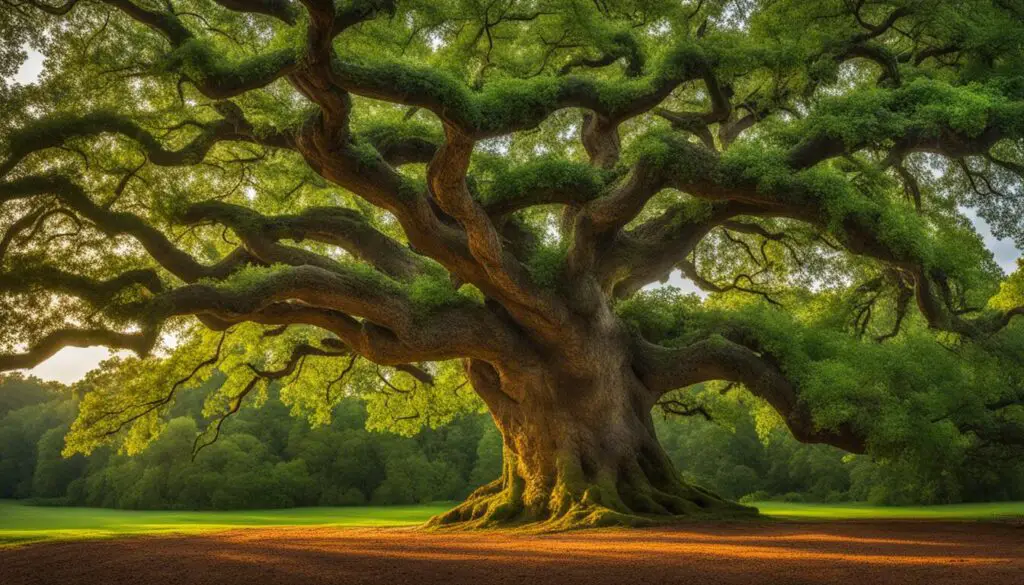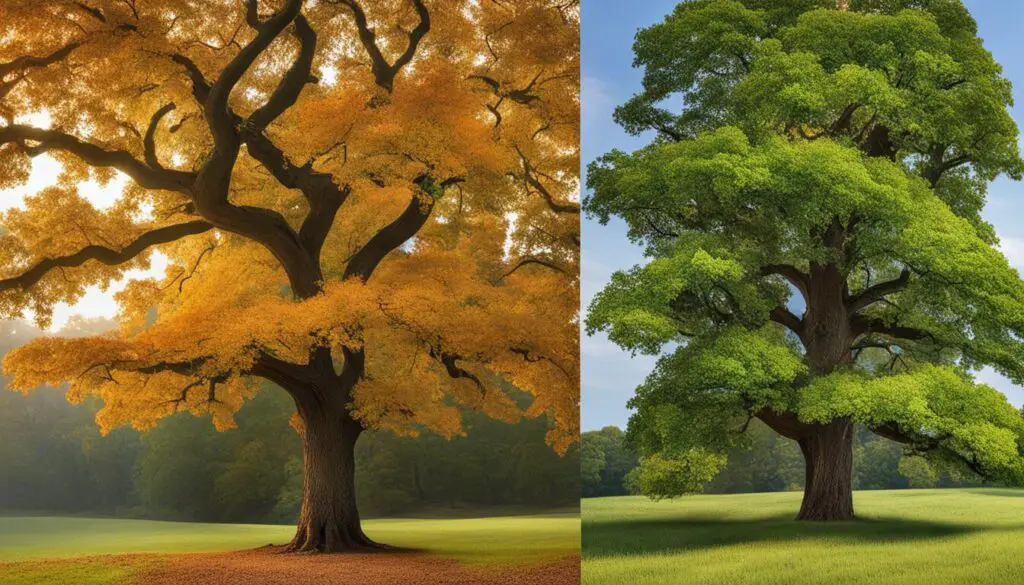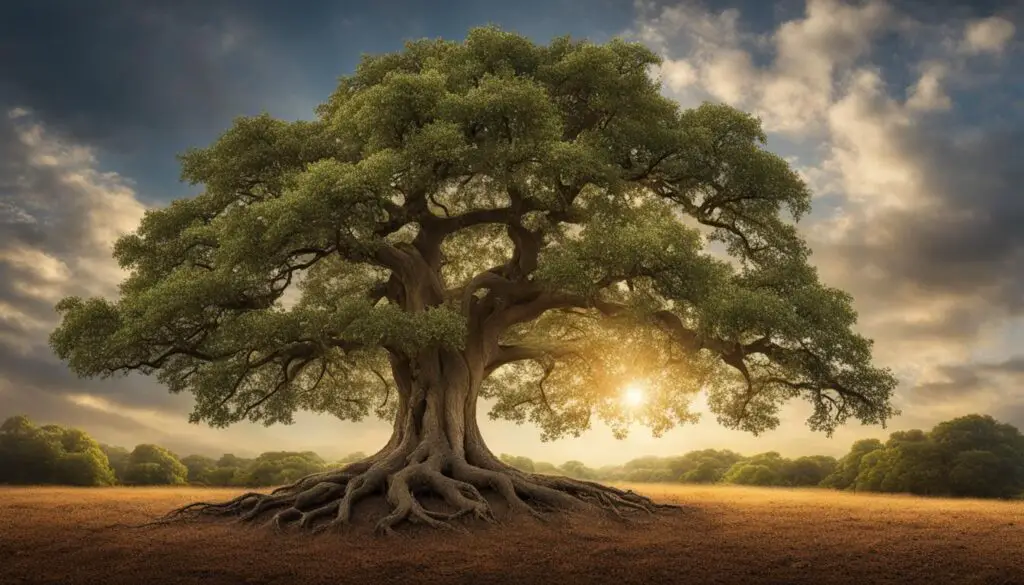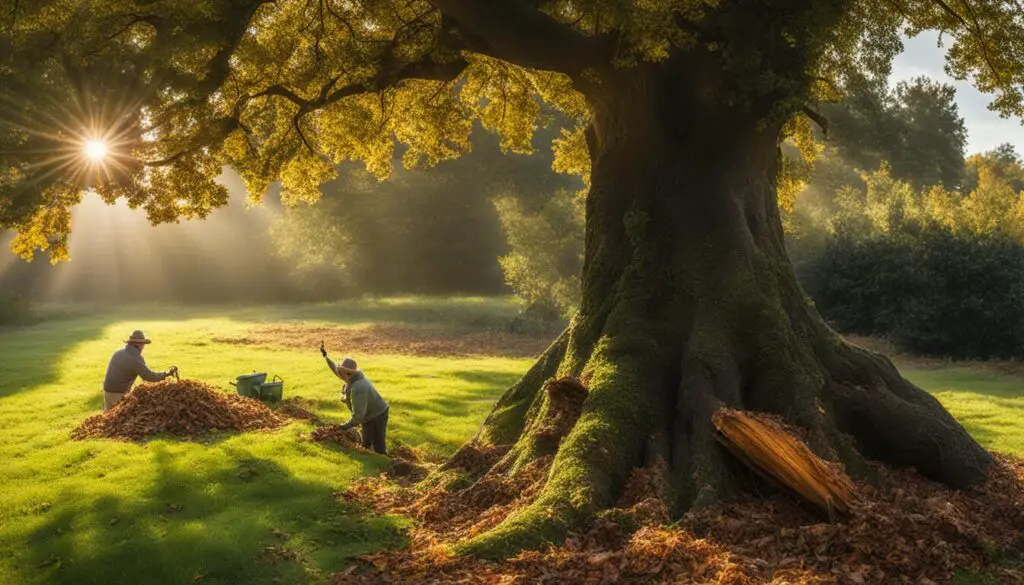In this article, we will explore the fascinating world of oak trees and uncover their unique traits. Oak trees belong to the beech family and consist of approximately 450 species of ornamental and timber trees and shrubs. These magnificent trees are found throughout the north temperate zone and at high altitudes in the tropics.
Key Takeaways:
- Oak trees are known for their acorns, which provide food for small game animals and can also be used for fattening swine and poultry.
- The wood of red and white oaks is highly valued and widely used in construction, flooring, and furniture.
- There are various species of oak trees, such as English oak, red oak, and white oak.
- Oak trees have distinct characteristics, including alternate, simple, deciduous or evergreen leaves with lobed, toothed, or entire margins.
- They are hardy, long-lived, and can be easily propagated from acorns.
Characteristics of Oak Trees
Oak trees exhibit a range of distinctive characteristics that set them apart from other tree species. These characteristics contribute to their resilience, longevity, and significance within ecosystems. Understanding the unique traits of oak trees is essential for appreciating their ecological importance and effectively identifying them.
Leaves
Oak trees have alternate, simple, deciduous or evergreen leaves with lobed, toothed, or entire margins. The shape and structure of the leaves can vary between different oak species. Some leaves have deep lobes, while others have smooth edges. This diversity in leaf morphology adds to the aesthetic appeal of oak trees.
Flowers and Acorns
One distinct feature of oak trees is that male and female flowers grow on the same tree. The female flowers, once pollinated, develop into acorns. Acorns are the fruit of oak trees and play a crucial role in their reproduction. These acorns take one to two seasons to mature, eventually falling from the trees and becoming an important food source for wildlife.
Leaf and Seed Variations
There are different types of oak trees, each with its own leaf and seed characteristics. White oaks have smooth leaves without bristles and yield sweet-tasting seeds. On the other hand, red and black oaks have bristle-tipped leaves and produce bitter fruits. These distinctions contribute to the variation found within the oak tree genus.
Hardiness and Longevity
Oak trees are known for their hardiness and longevity. They can withstand harsh environmental conditions and often thrive in a variety of habitats. This adaptability allows oak trees to establish themselves in diverse ecosystems and contribute to their stability and biodiversity. Oak trees have a remarkable lifespan, with some specimens living for over 1,000 years.
Propagation and Soil Preferences
Oak trees are relatively easy to propagate from acorns. This characteristic makes it possible to cultivate oak trees in various locations and promote their conservation. Depending on the species, oak trees thrive in moderately moist, nutrient-rich soils or dry sandy soils. Their ability to adapt to different soil conditions further contributes to their widespread distribution.
Overall, the characteristics of oak trees, from their leaves and flowers to their hardiness and propagation methods, make them fascinating and valuable components of natural environments. Understanding these characteristics not only aids in the identification of oak trees but also deepens appreciation for their ecological role and cultural significance.
Oak Tree Species and Uses
The taxonomy of the genus Quercus is confusing due to the many natural hybrids. Oak trees can be separated into three groups: white oaks, red and black oaks, and cyclobalanus. In North America, oak species like pin oak, northern red oak, white oak, and bur oak are of ornamental landscape value. Many oaks native to the Mediterranean area have economic value, such as the cork oak, Aleppo oak, and kermes oak. Oak trees are also cultivated as ornamentals, including the English oak and various Asian species. Oaks have a wide range of uses, including lumber for construction, flooring, furniture, and the production of crossties and mine props.

Oak trees are incredibly diverse, with each species offering unique characteristics and uses. Here is a table highlighting some common oak tree species and their uses:
| Oak Tree Species | Uses |
|---|---|
| White Oak | Lumber for construction, flooring, and furniture |
| Red Oak | Lumber for construction, furniture, and crossties |
| English Oak | Lumber for construction, fine furniture, and shipbuilding |
| Cork Oak | Cork production for wine stoppers and other cork products |
| Aleppo Oak | Timber for construction, flooring, and furniture |
| Kermes Oak | Tannin production for leather tanning and dyeing |
Each oak tree species offers distinct characteristics and properties that make them suitable for various applications. Whether it’s the sturdy and durable wood of white oak used in construction or the flexible and resilient cork produced by the cork oak, oak trees have been utilized by humans for centuries.
Oak Tree Identification
When it comes to identifying oak trees in the UK, two native species stand out: English oak and sessile oak. Each species has its own distinct features that make identification possible.
English Oak: English oak is characterized by its sprawling, twisted branches and rough, ridged bark. The leaves of English oak have 5-6 deep lobes with smooth edges. In spring, the leaves emerge a bright green color, then transition to yellow, golden, and deep rust hues in autumn.
Sessile Oak: Sessile oak, on the other hand, has a more compact and rounded crown with smooth bark. Its leaves are similar to those of English oak, with 5-6 deep lobes and smooth edges. Sessile oak leaves often have a glossy appearance.
As the seasons change, oak trees reveal their unique characteristics through their growth patterns. Oak trees produce long-hanging yellow catkin-style flowers and develop acorns that transition from green to brown before falling in early autumn. These distinctive features aid in the identification process and allow for a deeper appreciation of these majestic trees.
By recognizing the specific traits of English oak and sessile oak, both novices and experts can confidently identify oak trees in the UK.
Oak Tree Lifespan
Oak trees are known for their incredible longevity, with some species reaching an astonishing lifespan of over 1,000 years. The journey of an oak tree begins as an acorn, which germinates and grows into a seedling, then a sapling, and eventually a young tree. As the oak tree matures and reaches adulthood at around 100 years old, it enters a phase of peak growth and starts producing large crops of acorns.
However, as the oak tree ages, its growth gradually slows down. After approximately 700 years, the tree enters old age, and its growth further declines. By the time the oak tree reaches the impressive age of 1,000 years, it begins to die, marking the end of its remarkable lifespan.

| Age of Oak Tree | Development Stage |
|---|---|
| 0-100 years | Seedling, sapling, and young tree |
| 100-700 years | Adulthood and peak growth |
| >700 years | Old age |
| >1,000 years | Dying phase |
The long lifespan of oak trees is a testament to their resilience and endurance in the face of time. It is a reminder of the importance of preserving these majestic trees and the ecosystems they support.
Oak Trees and Wildlife
Oak trees play a crucial role in supporting wildlife, making them an essential component of ecosystems. They provide habitat, food, and shelter for numerous species of insects, birds, mammals, and more. Oak trees support more life forms than any other native tree species in the UK, highlighting their importance in maintaining biodiversity.
British birds, such as tits and warblers, rely on oak trees for the abundant supply of insects found on their branches and leaves. These insects serve as a vital food source for bird populations, especially during the breeding season. Additionally, oak trees produce acorns, which are a valuable food source for badgers, deer, and other woodland creatures.
The fallen leaves of oak trees create a rich mould on the forest floor, providing a habitat for a range of insects and beetles. These insects, in turn, attract birds and bats, contributing to the diversity of wildlife in woodlands. Oak trees offer a multitude of nesting sites and hiding places for small mammals and birds, ensuring their survival and enabling them to thrive.
Oak trees also support a variety of microorganisms that contribute to the breakdown of organic matter and the cycling of nutrients, further enriching the ecosystem. The complex and interconnected web of life that oak trees sustain underscores their vital role in supporting wildlife populations.
In recognition of the crucial role that oak trees play in supporting wildlife, conservation efforts often focus on preserving and protecting these majestic trees and the habitats they provide. By safeguarding oak trees, we can help maintain the delicate balance of nature and ensure the continued survival of diverse wildlife species.
Symbolism of Oak Trees
Oak trees have long been revered as powerful symbols of strength and survival. Throughout history, oak trees have held deep cultural and historical significance, representing resilience and endurance. In English culture, oak trees have played a prominent role, with ancient kings adorning oak leaf crowns as a symbol of their authority and connection to nature.
The symbolism of oak trees goes beyond their physical characteristics. These majestic trees have been associated with environmental harmony, reflecting the interconnectedness of all living beings and the importance of preserving the natural world. The oak tree has even become a national symbol, embodying the values and ideals of a nation.
In the words of William Bryant Logan, “The oak tree is epitome and emblem of Britain itself: an island whose deep past, vast umbra, and secret interim offer wisdom, strength, and survival.”
Image:

Oak Tree Care
Proper care and maintenance are essential for the healthy growth and longevity of oak trees. By providing the necessary attention and protection, you can ensure that your oak trees thrive and continue to contribute to the natural environment.
Pruning for Healthy Growth
Pruning is an important aspect of oak tree care, especially for young trees. By pruning to develop a strong central leading branch, young oak trees can establish a sturdy and well-balanced structure.
Additionally, mature oak trees should be pruned to remove dead wood and broken branches. This not only enhances their aesthetic appearance but also prevents potential hazards and promotes healthy growth.
Remember, timing is key when it comes to pruning oak trees. It is best to prune during their dormant season, typically in late winter or early spring, to minimize the risk of disease and ensure successful healing.
Protection from Pests and Diseases
Oak trees can be susceptible to pests and diseases that can hinder their health and vitality. Common pests that affect oak trees include oak gall wasps, leaf-mining moths, and aphids. These pests can cause damage to leaves and disrupt the tree’s overall well-being.
Furthermore, oak trees may face diseases like Oak Decline, including Acute Oak Decline and Chronic Oak Decline. These diseases can lead to a decline in tree health and vigor, posing a threat to their longevity.
To protect your oak trees, regular monitoring and appropriate measures to control pests and diseases are crucial. Consult with a professional arborist or horticulturist for guidance on effective treatments and preventive strategies.

Maintaining Oak Tree Health
In addition to pruning and pest control, there are several other measures you can take to maintain the overall health of your oak trees:
- Provide adequate watering, particularly during dry periods, to keep the soil moist but not waterlogged.
- Avoid compacting the soil around the base of the tree to facilitate proper root growth and nutrient absorption.
- Apply mulch around the base of the tree to conserve soil moisture and suppress weed growth.
- Regularly inspect the tree for signs of stress, such as wilting leaves, discoloration, or unusual growth patterns.
- Implement a fertilization program tailored to the specific needs of oak trees to ensure they receive the necessary nutrients.
By following these care practices and paying close attention to your oak trees’ needs, you can contribute to their long-term health and ensure their continued beauty in your landscape.
Oak Tree Identification Tips
When identifying oak trees, it’s important to pay attention to their distinctive features. Here are some tips to help you accurately identify oak trees:
- Branches: Oak trees often have sprawling, twisted branches. This unique branching pattern can help you differentiate them from other tree species.
- Bark: Look for rough, ridged bark on oak trees. The texture and appearance of the bark can vary depending on the species.
- Leaves: Oak tree leaves are typically characterized by deep lobes and smooth edges. The lobes can vary in number and shape, so be sure to observe the leaves closely.
- Flowers: Pay attention to the appearance of flowers on oak trees. While not always prominent, observing the flowers can provide additional clues for identification.
- Acorns: Oak trees produce acorns, which can be a helpful identifying feature. Note the size, shape, and color of the acorns when trying to determine the species.
- Seasonal Changes: Lastly, take note of any changes in leaf color throughout the seasons. Oak trees often exhibit vibrant autumn colors, which can aid in identification.
By examining these characteristics and using these tips, you’ll be better equipped to identify oak trees with confidence.
Oak Tree Uses
Oak trees have been prized for centuries for their multitude of uses in various industries. The durable and beautiful wood of red and white oaks is highly valued and utilized in construction, flooring, furniture, millwork, cooperage, and the production of crossties, structural timbers, and mine props.
Additionally, oak trees hold cultural significance and are often cultivated as ornamentals in landscapes for their majestic presence and natural beauty. Their robust and enduring nature makes them a favorite choice for creating a timeless and elegant aesthetic.
Furthermore, oak trees provide essential habitat for a diverse range of wildlife. The dense canopy, sturdy branches, and abundance of acorns offer shelter and sustenance for numerous species, contributing to the overall biodiversity and ecological balance of ecosystems.
| Industry | Uses |
|---|---|
| Construction | Structural timber, beams, posts |
| Flooring | Hardwood flooring, parquet |
| Furniture | Tables, chairs, cabinets |
| Millwork | Moldings, doors, paneling |
| Cooperage | Barrels, casks |
| Crossties | Railroad ties, sleepers |
| Mine Props | Support structures |
Threats to Oak Trees
Oak trees are susceptible to a range of threats that can impact their health and vitality. Pests and diseases pose significant risks to oak trees, requiring proactive monitoring and intervention to mitigate potential damage.
Pests
Oak trees face several pests that can harm their health. Oak gall wasps, leaf-mining moths, caterpillars, and aphids are common pests that feed on oak tree foliage and sap, leading to defoliation, reduced growth, and overall decline in tree health.
Diseases
Oak Decline is a collective term for two diseases that affect oak trees: Acute Oak Decline (AOD) and Chronic Oak Decline (COD). AOD is characterized by dark weeping patches on the trunk, dieback of the crown, and visible signs of bacterial activity. COD manifests as progressive dieback and rotting of the inner wood, leading to weakened structural integrity.
Both AOD and COD can result in the decline and death of oak trees if left untreated. Prompt identification and proper management strategies are crucial to prevent further spread and protect the health of oak tree populations.
| Pests | Diseases |
|---|---|
|
|
Protecting oak trees from these threats requires a multi-faceted approach, including regular monitoring, proper tree care, and prompt intervention when signs of infestation or disease are detected. By addressing these threats, we can preserve the health and longevity of these magnificent trees and safeguard their ecological importance.
Conclusion
Oak trees are remarkable and diverse members of the tree family, known for their distinct traits and characteristics. With their long lifespan, they provide valuable resources for wildlife and play a crucial role in supporting biodiversity. Beyond their ecological significance, oak trees hold deep cultural symbolism and are revered for their strength and resilience.
To ensure the health and preservation of oak trees, proper care and identification are essential. Regular maintenance, including pruning and protection against pests and diseases, helps to sustain their vitality. By giving oak trees the attention they deserve, we can ensure their continued growth and contribution to the natural environment.
In conclusion, oak trees are not just ordinary trees; they are magnificent organisms that deserve our admiration and protection. Their significance goes beyond being beautiful landscape features – they are champions of wildlife, symbols of strength, and guardians of our history. Let’s cherish and care for these majestic trees so that future generations can continue to marvel at their grandeur.
FAQ
What are oak trees?
Oak trees are a genus of about 450 species of ornamental and timber trees and shrubs in the beech family. They are known for their acorns and valuable wood used in construction and furniture.
What are the characteristics of oak trees?
Oak trees have alternate, simple, deciduous or evergreen leaves with lobed, toothed, or entire margins. They produce acorns, and different species have different leaf types and fruit flavors.
How many types of oak trees are there?
There are many types of oak trees, including English oak, red oak, white oak, pin oak, northern red oak, bur oak, cork oak, Aleppo oak, kermes oak, and more.
How can oak trees be identified?
Oak trees can be identified by their distinctive features such as branching patterns, bark texture, leaf shape, flowers, acorns, and changes in leaf color throughout the seasons.
How long do oak trees live?
Oak trees have a remarkable lifespan and can live for over 1,000 years. They go through stages of growth, peak growth, and aging before eventually dying.
How do oak trees support wildlife?
Oak trees support a diverse range of life forms and provide habitat, food, and shelter for hundreds of species of insects, birds, mammals, and other animals.
What is the symbolism of oak trees?
Oak trees symbolize strength and survival. They have cultural and historical significance, and are considered national symbols in certain countries.
How should oak trees be cared for?
Oak trees require regular pruning to develop a strong structure, remove dead wood, and promote healthy growth. Protection against pests and diseases is also important for their health.
What are some oak tree identification tips?
When identifying oak trees, look for features such as branching patterns, bark texture, leaf shape, flowers, acorns, and changes in leaf color throughout the seasons.
What are the uses of oak trees?
Oak trees have versatile uses in various industries, including construction, flooring, furniture, cooperage, and the production of crossties, structural timbers, and mine props.
What threats do oak trees face?
Oak trees can be affected by pests such as oak gall wasps, leaf-mining moths, and aphids, as well as diseases like Oak Decline. Monitoring and management are important for their preservation.
What is the conclusion about oak trees?
Oak trees are a diverse genus of trees and shrubs with distinctive traits. They have cultural significance, support wildlife, require proper care, and contribute to the natural environment.

